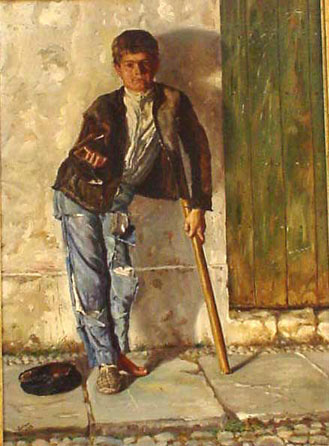Via Margutta

José Gallegos had a very large apartment in the via Ripetta in Rome. This was near the Piazza del Popolo, and was above an apartment occupied by the ‘Generale’ of the Jesuit order. The building was old and evidently in need of restoration, for one day his cook, who like so many cooks was considerably overweight, was shocked to find the kitchen floor collapsing underneath her. She arrived through the ceiling of the Jesuits apartments, which was strictly forbidden ground to women. The priests however took this as a miracle, and news of the event was published the next day in the official Vatican newspaper, the Osservatore Romano, ”…. and the priests cried falling to their knees, an angel from heaven”. José owned three studios joined together at number 54 in the Via Margutta, where many other well-known painters had their studios. The studio was heavily decorated with carved baroque mirrors and columns, and with Greek and Roman statues around the walls. It seemed more like an antique shop with the many items which he used as backdrops for his paintings. He loved beauty in all its forms, and he always picked the prettiest models he could find. At that time they were paid 5 lire a day, and for such a price they were expected to remain in the studio for the whole day, whether they were being painted or not. In addition to his apartment in the via Ripetta, he built a large villa in the Parioli district above Rome, not far from the Piazza Ungheria. In 1880 this was not yet bult up, and was where Romans would go for a day out in the country.
Every summer he would rent a villa at Nettuno on the coast near Anzio. He liked shooting, and at Nettuno he employed a ‘cacciatore’ called Anselmo to look after his dogs. His main recreation, however, when on holiday was painting the countryside around the villa in watercolours or pastel, and some of these pictures and sketches still remain in the artist’s family. When he died, which was towards the end of the first world war, he was owed large sums of money by his German dealer. This posed great financial hardship on his widow, who still had small children to bring up and educate. When she was eventually paid, it was in bundles of valueless German marks, and as a result she had to sell all of José’s remaining paintings, the money from which she used to start the ‘Embassy tea-rooms’ near the Spanish steps in Rome, and which soon was to become a commercial success. José had always had sufficient success with his painting to be financially independent. At the age of sixteen he made his first sale, to an Englishman who was watching him sketching a cathedral. He offered him one pound, which was accepted without hesitation; today it may not appear to be much, but it certainly was in 1873. One of his earliest paintings is of a Crippled Boy which is in a private collection in Jerez. Alongside his work he enjoyed life to the full, travelling frequently , but rejecting any publicity. He was rarely seen in any social context, and may well have appeared to outsiders as unsociable. The reason for this was that as he had a ready market for his paintings at relatively high prices and he did not need any publicity. José died on the 21st September 1917 at two in the morning, barely 12 hours after the death of Lucas his eldest son by Constance. This was indeed a bitter blow for his widow to bear. He died from a stroke whilst watching a Corpus Christi procession in Nettuno, and was buried there with Lucas. It seems that his stroke was a direct result of an accident whilst wild boar hunting. In Italy wild boar are normally shot from camouflaged butts, but in this case there were no butts available, and José was in a tree from which he fell and injured his spine.
